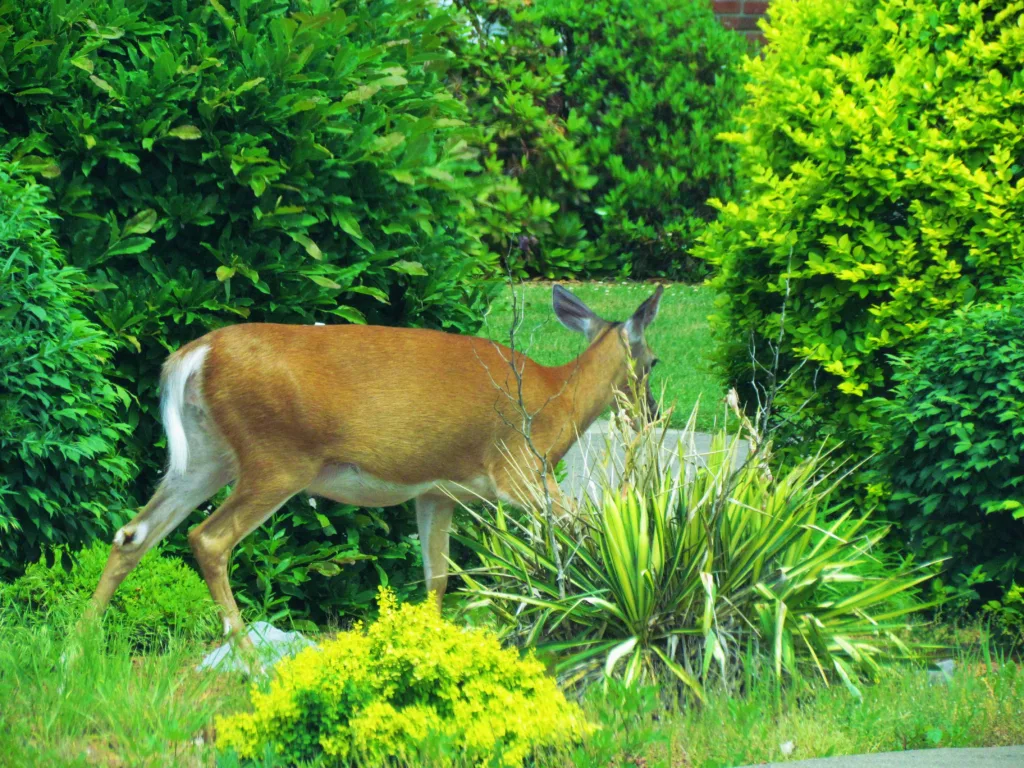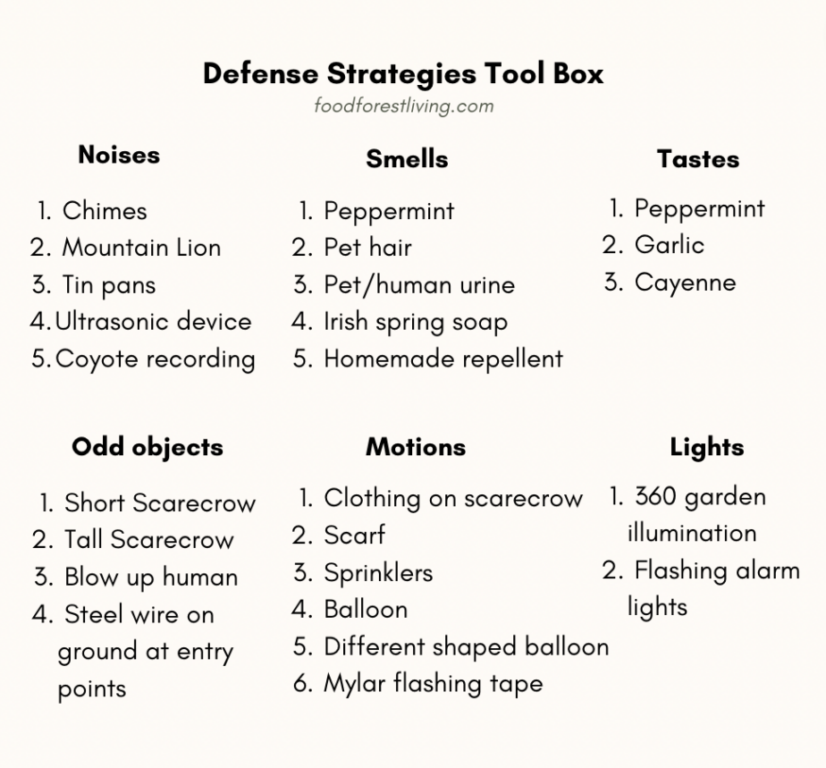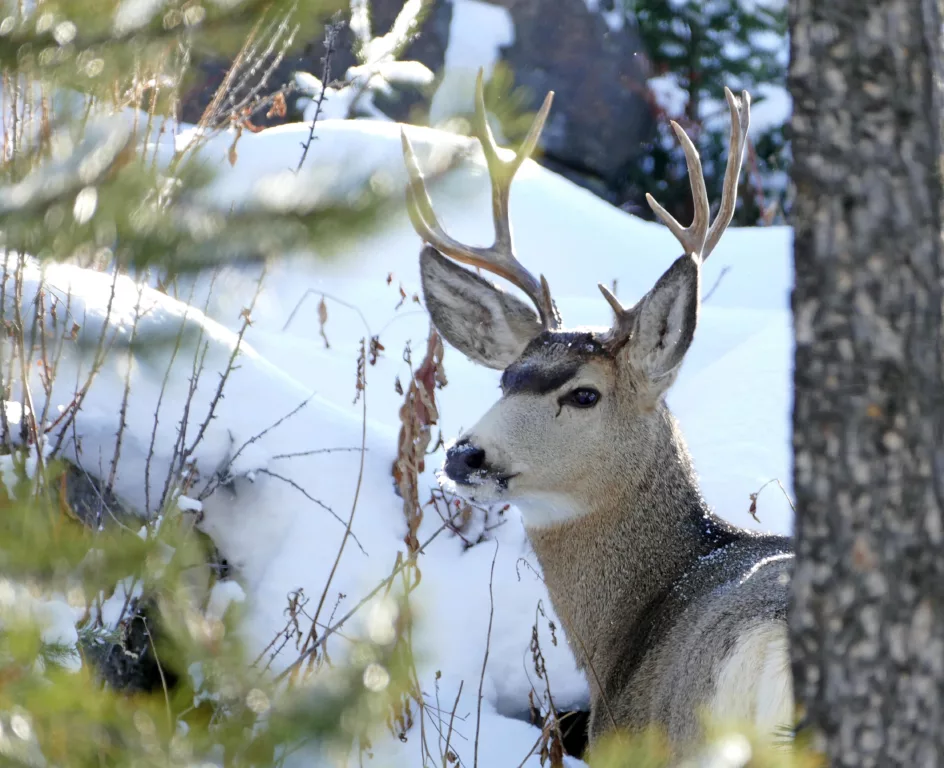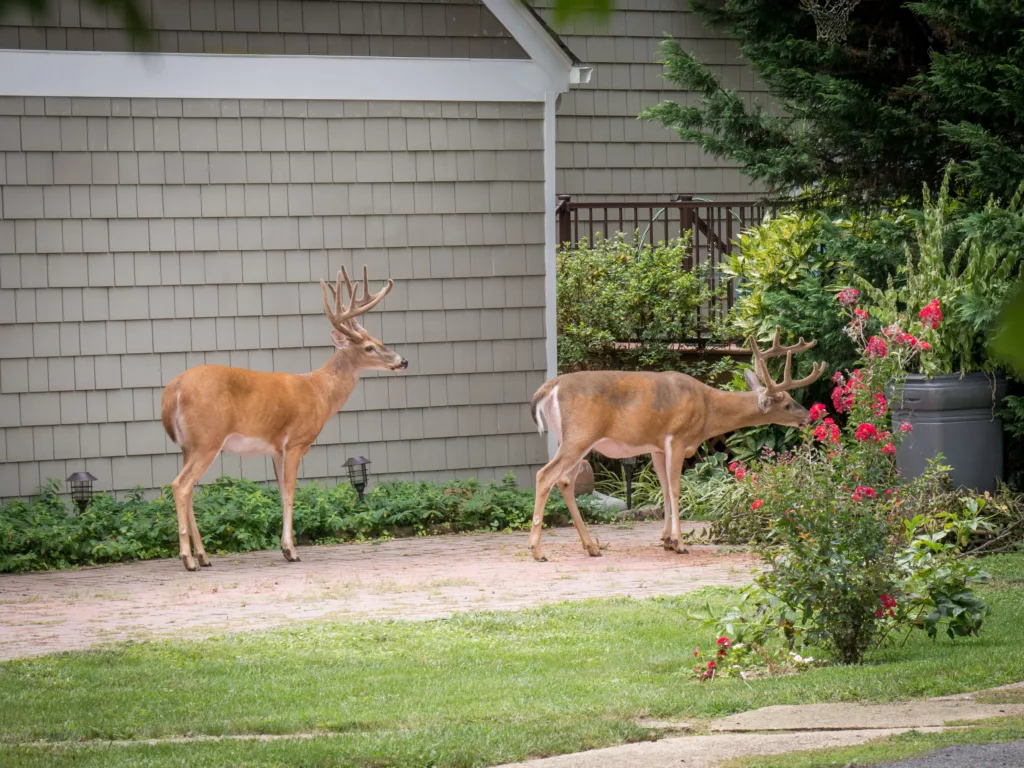This post may contain affiliate links. If you use these links to buy something we may earn a commission. Thanks.
Without a tall fence, keeping deer out of the garden is less straightforward than “setting it and forgetting it.”
A simple tactic-rotation schedule can eliminate the stress of researching and finding something that “works” (because the last thing you tried is no longer effective).
Deer are highly adaptive; the reason certain strategies don’t work forever is the same reason you’d get tired of eating the same salad.
Ever-changing strategies that target various senses and weaknesses can be as effective as a tall fence. Choose 1-3 noises, lights, smells, motions, tastes, and odd shaped objects to rotate on a schedule.
Seasonal variations such as weather, temperature, and deer habits must be accounted for to maintain an effective garden protection schedule.

Order deer-resistant shrubs, herbaceous perennials, bulbs, roses, and ground covers all in one place.
Your plan of action will be completely organized by the end of this post.
For a full list of effective noises, motions & objects, smells & tastes, objects, and lights; make your selection below:
- 11 Easy Noises & Sounds To Scare Deer Away For Good
- How To Create Motion with Household Items to Repel Deer
- 6 Recipes to Repel Deer by Smell & Taste + How To Use Them
- How to keep deer out of the garden at night
Pick 2-3 tactics of each category so you can maintain an unfamiliar territory with ease.

- Your spring schedule to keep deer away from the garden should include a variety of repulsive smells, tastes, noises, lights, odd objects, or animals, and unpredictable motions during rainy periods.
| Early March | Late March | Early April | Late April | Early May | Late May |
| smell 1 | smell 2 | odd object 2 | dog presence | taste 2 | smell 1 |
| noise 4 | lights 1 | motion 1 | odd object 1 | smell 3 | noise 5 |
| odd object 1 | taste 3 | noise 2 | motion 2 | noise 3 | odd object 2 |
| motion 2 | lights 2 | motion 4 |
Deer are hungry in spring and looking for your fresh hosta shoots, baby brassicas, and peas—a perfect time for a taste of spice and unpleasant or uneasy smells such as canine urine, or this recipe.
Each season and climate has different dry spells and wet spells so consider that scent-based and taste-based repellents will need to be applied after every rainfall.
Objects such as this mountain lion statue and motion-sensor-triggered noises or scary lights are better strategies for wet weeks.
When a dry week is expected, apply the repellent smells and spicy or garlicky tastes. Repulsive smells dissipate when they dry, so it’ll be fine for you, but not the keen sniffer of a deer.
- I use ‘taste’ in late march as tender plants are producing tender (and delicious) shoots at this time as the weather is warming up. You’ll want to pair poor-tasting greens with unpleasant or territorial ‘smells’ before the rain starts.
- I use noises, objects, and motions in April since “April showers bring May flowers.”
- As May warms and dries up, ‘smells’ are easily circulated and carried throughout the air and stay on for as long as it doesn’t rain.

2. Your summer schedule to keep deer away from the garden should include a variety of smells (you like, but deer don’t), pet presence, new noises, sprinklers, and new motions.
| Early June | Late June | Early July | Late July | Early August | Late August |
| motion 3 | smell 1 | odd object 2 | smell 4 | noise 4 | motion 6 |
| noise 4 | lights 1 | motion 2 | odd object 2 | smell 3 | taste 3 |
| odd object 1 | taste 1 | noise 5 | motion 3 | lights 2 | lights 1 |
| lights 1 | motion 3 | smell 4 | lights 2 | taste 3 | motion 3 |
In summer, you’ll likely be outside a lot and prefer not to have bad smells lingering in your garden.
Strong peppermint is pleasant for you, but deter deer as their sense of smell is much stronger than ours and is best applied during dry spells so you don’t need to dedicate excessive time or essential oils to deer-defending.
When the rain comes around, put out odd objects like creepy masks on stakes, noise-makers, and lights.
- I use smells 1 and 3 in summer as I need a break from mixing repulsive scented deterrents. We are outside a lot with the dog so the peppermint smells nice around where we work and the urine of whoever needs to go works fine on the outskirt borders of the area we are protecting and is good nitrogen for plants and trees.
- The noise made by motion-sensor devices is best used in warmer weather (in shade) rather than winter as the devices may not be suitable for freezing temperatures. Many devices are likely fine in winter, but I’d rather keep mine indoors during those times to preserve batteries and the longevity of equipment.
- Odd objects are great for all seasons. Motion-sensing sprinklers are reserved for late spring to early fall—frozen lines won’t exactly be effective at spraying!

3. Your Fall schedule to keep deer away from the garden should include a variety of rain-friendly odd objects, predatory clues, unstable walking areas, new noises, and new motions.
| Early Sept | Late Sept | Early Oct | Late Oct | Early Nov | Late Nov |
| taste 2 | smell 1 | odd object 2 | smell 2 | noise 4 | motion 6 |
| noise 4 | lights 1 | motion 5 | odd object 1 | smell 3 | taste 3 |
| odd object 4 | taste 3 | noise 2 | motion 3 | lights 2 | lights 1 |
| lights 1 | motion 3 | smell 4 | lights 2 | odd object 4 | motion 3 |
- When harvests are at an all-time high in fall, use stronger defenses such as a repulsive-smelling homemade repellent concoction to keep them at bay and lay down some steel wire (odd object 4) where they would typically attempt walking to keep them away from your food
- A funny-shaped balloon or two can be relocated every time you’re outside tending or harvesting plants to keep nighttime scavenging at bay
- A motion-sensing light can be positioned to illuminate the moving balloon while also illuminating the garden.
- As a last resort during this time, place the motion-sensing speaker with a new noise near your most prized plants to keep them off if they found a way in without a startle.

Up next: the most tempting season to skip out on deer defense, but is the most important for a successful season: winter.
4. Your winter schedule to keep deer away from the garden should include a variety of odd objects, predatory scents, unpredictable movements, new noises, and new motions.
| Early Dec | Late Dec | Early Jan | Late Jan | Early Feb | Late Feb |
| taste 3 | smell 2/3 | odd object 3 | smell 2 | noise 4 | motion 6 |
| noise 5 | lights 1 | motion 5 | odd object 1 | smell 3 | taste 3 |
| odd object 4 | taste 3 | noise 2 | motion 3 | lights 2 | lights 1 |
| lights 2 | motion 6 | smell 2/3 | lights 2 | motion 6 | motion 3 |
- When plants have died back there’s not much to put unpleasant tastes on. Young tree branches are about all if you’re protecting those. Walking through the snow, however, is a big job unless you fancy snowshoeing—we do!
Smells and tastes can take a general back seat, but of course, if you have a pet. . . they can (and will) continue to pee outside.
Noise, movement, and motion—with light options for nighttime—should be plenty for winter defense.
- Noises from chimes (1) or tin pans (3) are well saved for freezing temperatures as those objects aren’t impacted by the cold and usually hang up and out of the snow. Once in a while, you might want to put out a coyote recording if they seem to be getting comfortable.
- Odd objects can be relocated often. Get outside and switch out the locations, numbers, and appearance of your odd objects. Add movement onto them using wind as an advantage with lightweight silk fabrics or flashy mylar tape.
- The schedule is set to change things up every 2 weeks. This may be sufficient, but as things are generally quieter in winter, human-wise, you may want to get outside often yourself, at least every week to ensure commotion is always a thing in your yard.
The last thing you want is for deer to get comfortable with the tactics over the winter because you over-used them.
If you feel like you’ll easily neglect your deer defense over the winter time, I suggest you keep a separate winter set of tactics. That way, all your growing-season tactics are fresh, uneasy, and unworn.

This article was originally published on foodforestliving.com. If it is now published on any other site, it was done without permission from the copyright owner.
You may be thinking—why do I need to do all this in winter?
Deer easily get comfortable and stay comfortable. We’ve nearly walked up to a young buck and petted it. We weren’t going to. But I’ve heard stories of my cousins doing so on their farm.
It’s important not to let the local deer get accustomed to your area at all. Once they habitually visit, it is more difficult to change the habit to keep them away.
As they are comfortable, they are more likely to inspect your deterrents. You don’t want them to inspect your deterrents and figure out that they’ll cause no harm.
Once they figure out the harmlessness of your defenses; game over. That is why many “tactics” stop working. They are predictable.
Stay unpredictable, always. Unfortunately, if you don’t want to pay the price of a fence—you’ll pay by way of scheduling in the setup and take down of various creative scare tactics.
How to keep deer scare tactics from failing

Whatever you do, don’t just put up all the items in your ‘toolbox,’ leave them forever, and expect lasting results.
The whole strategy works because it is ever-changing.
Even tall fences begin to fail as deer become comfortable investigating environments that lack commotion.
Deer prevention is much easier than ridding deer who already frequent your spot like a Tuesday night buffet.
To rid deer who know and love your plants, I found this interesting tool (not sponsored or tried) that “trains” them to keep away from your yard. If I needed to, I’d start with this, then phase in the schedule to prevent deer from coming back into your garden at all.
Changing things up as creatively as possible will keep deer second-guessing your area, and maintain their distance.
The longer they see the same thing, the more confident they become and have the desire to inspect familiarity. Keep a careful eye out and do what you need to protect your plants without a fence!
Up next: The Best Fence to Keep Deer Out (Cheaper & Easier Too)
Recent Posts
There’s no shortage of full-sun ground covers for zone 4 climates! Each plant in this list can withstand the frigid temperatures and also enjoy the hot sun in summer. Full sun means that a plant...
There's no shortage of full sun ground covers, not even in zone 3! Zone 3 climates offer hot but short-lived summers and very cold winters. So each plant in this list can withstand the frigid...
